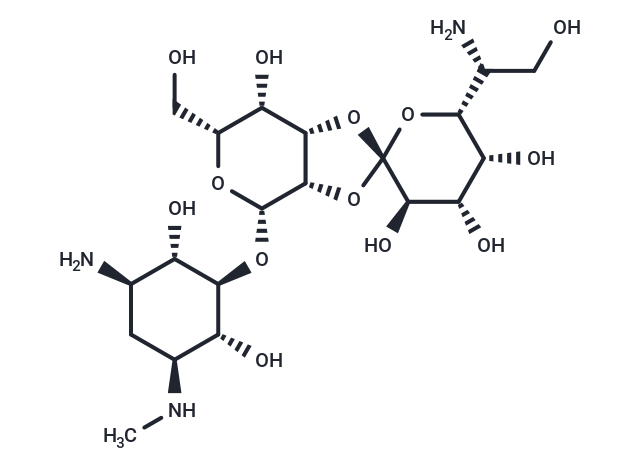Shopping Cart
Remove All Your shopping cart is currently empty
Your shopping cart is currently empty
Hygromycin B (Hygrovetine) is an aminoglycoside antibiotic that inhibits protein synthesis in both prokaryotic and eukaryotic cells by interfering with translocation and causing mistranslation by the 70S ribosome. It is commonly used for the selection of cells transfected with the hph or hyg resistance gene.

| Pack Size | Price | USA Warehouse | Global Warehouse | Quantity |
|---|---|---|---|---|
| 100 mg | $35 | In Stock | In Stock | |
| 200 mg | $48 | In Stock | In Stock | |
| 500 mg | $70 | In Stock | In Stock | |
| 1 mL x 10 mM (in DMSO) | $54 | In Stock | In Stock |
| Description | Hygromycin B (Hygrovetine) is an aminoglycoside antibiotic that inhibits protein synthesis in both prokaryotic and eukaryotic cells by interfering with translocation and causing mistranslation by the 70S ribosome. It is commonly used for the selection of cells transfected with the hph or hyg resistance gene. |
| Targets&IC50 | E. coli:20 μg/mL (MIC) |
| In vitro | METHODS: Mouse PDAC cells 14387T were transfected with lentiCRISPRv2 hygro lentivirus, and after 48 h, the transfected cells were cultured in new medium containing Hygromycin B (500 μg/mL) for two weeks, and the successful transfected cells were screened.
RESULTS: Hygromycin B screened the lentivirally successfully transfected cells. [1] METHODS: E. coli was cultured in medium containing Hygromycin B (0-8 μg/mL) and cell growth was monitored using a Klett-Summerson colorimeter. RESULTS: Hygromycin B reduced the number of viable cells and increased doubling time in a concentration-dependent manner.Hygromycin B inhibited the number of viable cells by 50% at a concentration of 20 μg/mL, and halved the rate of growth at a concentration of 25 μg/mL. [2] |
| In vivo | METHODS: To assay antiviral activity in vivo, Hygromycin B (0-5 μmoL/kg) was administered intraperitoneally to MHV-A59-infected BALB/c mice twice daily for three days.
RESULTS: Hygromycin B was able to reduce the levels of viral replication and necrotic liver foci in vivo. [3] |
| Synonyms | Hygrovetine |
| Molecular Weight | 527.52 |
| Formula | C20H37N3O13 |
| Cas No. | 31282-04-9 |
| Smiles | CN[C@H]1C[C@@H](N)[C@H](O)[C@@H](O[C@@H]2O[C@H](CO)[C@H](O)[C@@H]3O[C@@]4(O[C@H]23)O[C@H]([C@H](N)CO)[C@H](O)[C@H](O)[C@H]4O)[C@@H]1O |
| Relative Density. | 1.67 g/cm3 |
| Color | White |
| Appearance | Solid |
| Storage | keep away from moisture | Powder: -20°C for 3 years | In solvent: -80°C for 1 year | Shipping with blue ice/Shipping at ambient temperature. | |||||||||||||||||||||||||||||||||||
| Solubility Information | DMSO: 240 mg/mL (454.96 mM), Sonication is recommended. H2O: 125 mg/mL (236.96 mM), Sonication is recommended. | |||||||||||||||||||||||||||||||||||
| In Vivo Formulation | 5% DMSO+95% Saline: 1.58 mg/mL (3 mM), Solution. Saline: 50 mg/mL (94.78 mM), Solution. 10% DMSO+90% Saline: 3 mg/mL (5.69 mM), Solution. Please add the solvents sequentially, clarifying the solution as much as possible before adding the next one. Dissolve by heating and/or sonication if necessary. Working solution is recommended to be prepared and used immediately. The formulation provided above is for reference purposes only. In vivo formulations may vary and should be modified based on specific experimental conditions. | |||||||||||||||||||||||||||||||||||
Solution Preparation Table | ||||||||||||||||||||||||||||||||||||
H2O/DMSO
| ||||||||||||||||||||||||||||||||||||
| Size | Quantity | Unit Price | Amount | Operation |
|---|

Copyright © 2015-2026 TargetMol Chemicals Inc. All Rights Reserved.